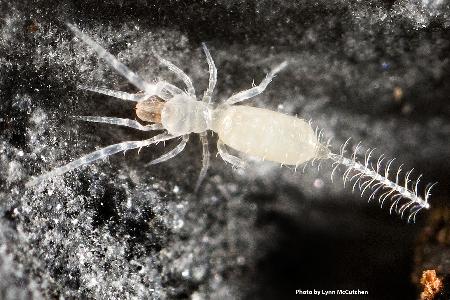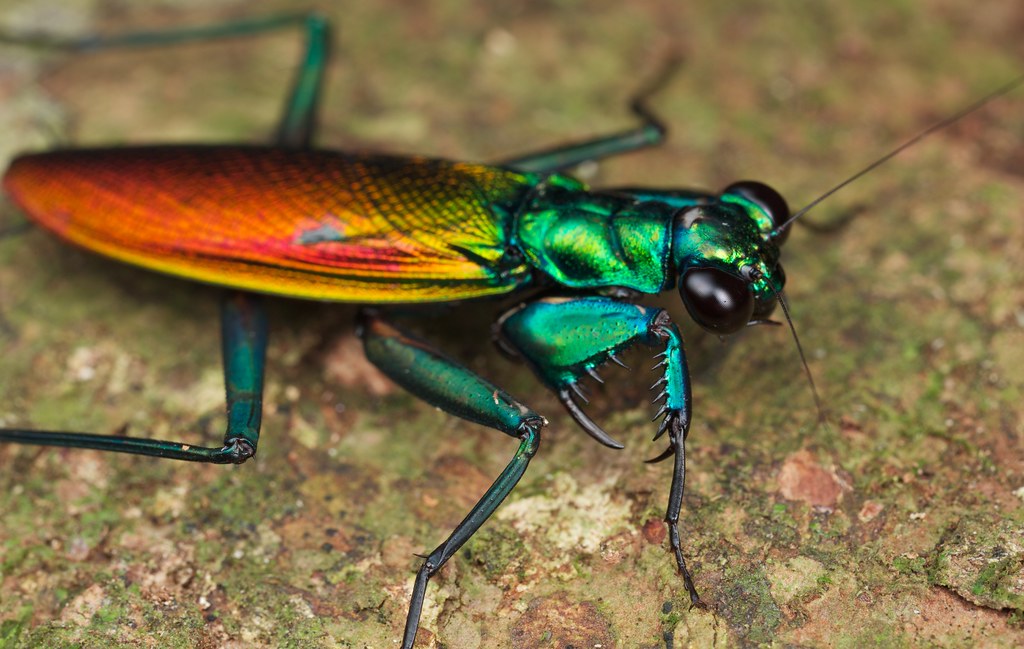 |
| Prokoenenia wheeleri (Palpigradi: Prokoeneniidae) from Texas; attribution shown |
Just within the past year and a half, three (count 'em, three) new insect orders have been described from Hukawng Valley burmite: namely, the Alienoptera (Bai et al., 2017), Aethiocarenodea (Poinar & Brown, 2017), and Tarachoptera (Mey et al., 2017). (And this is not even to mention the Permopsocida, an order that was established for Permian-Cretaceous insect taxa after the description of a specimen from the Hukawng Valley; Huang et al., 2016). After we pick our collective mandibles up off the floor, we should consider each of these taxa in turn: are their ordinal statuses truly defensible? Or, perhaps, are these better regarded as stem-groups of extant taxa?
 |
| Kinitocelis divisinotata, holotype (adult female) |
 |
| Wing scales of Kinitocelis brevicostata (Tarachoptera: Tarachocelidae) |
 |
| Head profiles of basal trichopterans and lepidopterans (23-24) and K. brevicostata (Tarachoptera; 25) |
While eccentric autapomorphies juxtaposed with basal traits amount to a syndrome typical of stem-groups all across the tree of life, the fact that one cannot argue that Tarachocelidae is more closely akin to either the Trichoptera or Lepidoptera leads me to agree that one could parsimoniously grant the Tarachoptera ordinal rank. However, whether this is necessary is another question.
 |
| Type specimen of Aethiocarenus burmanicus |
 |
| Profile of A. burmanicus holotype head |
By contrast, the (again monotypic) Alienoptera are clearly akin to mantises (Mantodea). Described from a single male specimen of Alienopterus brachyelytrus (Bai et al., 2016), the taxon is a creature with a triangular head and bristly profemora not unlike those of the most ancient mantids. While most of the features that define the Dictyoptera (cockroaches, termites, and mantises) cannot be falsified on the specimen of A. brachyelytrus, the presence of a profemoral brush (otherwise unique to the Mantodea) and excellently preserved genitalia clinch its classification therein.
 |
| Alienopterus brachyelytrus: enlarged arolia, tegmina, and orthognathous head are all visible |
In my opinion, no. To begin with, a strict consensus tree using 58 morphological characters firmly placed Al. brachyelytrus as the sister group to the Mantodea (Bai et al., 2016). Even the 30% of this male specimen's genitalia that is visible, a suite of body parts that Bai et al. (2016) duly note have evolutionary plasticity to a degree that they may differ even within the same order (Klass, 1997), "fully conform to the condition within" mantises. Moreover, the characters that exclude Al. brachyelytrus from the Mantodea are mostly "retained ancestral conditions", making this mantodean sister-group not a mantis by dint of lacking derived mantodean traits.
Al. brachelytrus is as such not excluded from the Mantodea because it has closer kin elsewhere, but because it lacks some (but not all) of the derived traits that define that order: the status of the Alienoptera is thus contingent upon how broadly one wishes to spread the definition of the Mantodea. The bounds of that definition—where a basal dictyopteran more closely related to mantises than to any other extant taxon becomes itself a "mantis"—are subjective.
 |
| Nymph and adult of Cryptocercus punctulatus (Cryptocercidae); photograph by David R. Maddison |
 |
| Bornean Metallyticus splendidus (Metallyticidae); photographed by Paul |
In conclusion, I think that of the Alienoptera, Aethiocarenodea, and Tarachoptera, only the latter order is truly deserving of that rank, given the information now available. However, I admit that further data could lend support to the Aethiocarenodea: I think that a comprehensive search of other Cretaceous ambers for kin to this enigmatic little creature is in order.
*A derived trait unique to a particular taxon.
†A sclerite immediately adjacent to the base of the insect wing, providing a place of attachment to the pleural wing muscle.
‡Ingrowths of the exoskeleton, serving as attachments for muscles.
§With downward-directed mandibles.
||An unsegmented lobe extending from the tip of the insect tarsus, situated between the tarsal claws.
¶A derived trait (with reference to its ancestral state) in a particular taxon, but not one necessarily unique to that taxon.
__________________________________________________________
Bai, M.; Beutel, R. G.; Klass, K.-D.; Zhang, W.; Yang, X.; and Wipfler, B. (2016). Alienoptera — a new insect order in the roach–mantodean twilight zone. Gondwana Research, 39, 317-326.
Beutel, R. and Gorb, S. N. (2008). Evolutionary scenarios for unusual attachment devices of Phasmatodea and Mantophasmatodea (Insecta). Systematic Entomology, 33(3), 501-510. doi:
Burrows, M. and Dorosenko, M. (2015). Jumping mechanism and strategies in moths (Lepidoptera). Journal of Experimental Biology, 218, 265-266.
Engel, M. S.; Grimaldi, D. A.; and Krishna, K. (2009). Termites (Isoptera): Their Phylogeny, Classification, and Rise to Ecological Dominance. American Museum Novitates, 3650, 1-27. Retrieved 7/26/17 from http://www.bioone.org/doi/abs/10.1206/651.1
Engel, M. S.; Breitkreuz, L. C.; Cai, C.; Alvarado, M.; Azar, D.; and Huang, D. (2016). The first Mesozoic microwhip scorpion (Palpigradi): a new genus and species in mid-Cretaceous amber from Myanmar. Naturwissenschaften, 103(3-4), 19. doi: 10.1007/s00114-016-1345-4.
Huang, D.-Y.; Bechly, G.; Nel, P.; Engel, M. S.; Prokop, J.; Azar, D.; Cai, C.-Y.; van de Kamp, T.; Staniczek, A. H.; Garrouste, R.; Krogmann, L.; dos Santos Rolo, T.; Baumbach, T.; Ohlhoff, R.; Shmakov, A. S.; Bourgoin, T.; and Nel, A. (2016). New fossil insect order Permopsocida elucidates major radiation and evolution of suction feeding in hemimetabolous insects (Hexapoda: Acercaria). Scientific Reports, 2016(6), 23004. doi: https://dx.doi.org/10.1038%2Fsrep23004
Huxley, J. and Barnard, P. C. (1988). Wing scales of Pseudoleptocerus chirindensis Kimmins (Trichoptera: Leptoceridae). Zoological Journal of the Linnean Society, 92, 285-312.
Klass, K.-D. (1997). The external male genitalia and the phylogeny of Mantodea and Blattaria. Bonner Zoologische Monographien, 42, 1-341.
Kristensen, N. P. (1984). Studies on the morphology and systematics of primitive Lepidoptera (Insecta). Steenstrupia, 10, 141-191.
Kristensen, N. P.; Hilton, D. J., Kallies, A.; Milla, L.; Rota, J.; Wahlberg, N.; Wilcox, S. A.; Glatz, R. V.; Young, D. A.; Cocking, G.; Edwards, T.; Gibbs, G. W.; and Halsey, M. (2014). A new extant family of primitive moths from Kangaroo Island, Australia, and its significance for understanding early Lepidoptera evolution. Systematic Entomology, 40, 5-16.
Mey, W.; Wichard, W.; Mueller, P.; and Wang, B. (2017). The blueprint of the Amphiesmenoptera-Tarachoptera, a new order of insects from Burmese amber (Insecta, Amphiesmenoptera). Fossil Record, 20, 129-145. Retrieved 7/16/17 from www.foss-rec.net/20/129/2017/fr-20-129-2017.pdf
Perrichot, V.; Wang, B.; and Engel, M. S. (2016). Extreme Morphogenesis and Ecological Specialization among Cretaceous Basal Ants. Current Biology, 26, 1468-1472. Retrieved 7/25/17 from https://www.researchgate.net/publication/303544013_Extreme_Morphogenesis_and_Ecological_Specialization_among_Cretaceous_Basal_Ants
Poinar, G. Jr. and Brown, A. E. (2017). An exotic insect Aethiocarenus burmanicus (Aethiocarenodea ord. nov., Aethiocarenidae fam. nov.) from mid-Creataceous Myanmar amber. Cretaceous Research, 72, 100-104. Retrieved 7/16/17 from https://nature.berkeley.edu/garbelottoat/wp-content/uploads/insect3.pdf
Shi, G.; Grimaldi, D. A.; Harlow, G. E.; Wang, J.; Wang, J.; Yang, M.; Lei, W.; Li, Q.; and Li, X. (2012). Age constraint on Burmese amber based on U-Pb dating of zircons. Cretaceous Research, 37, 155-163. Retrieved 7/25/17 from http://www.sciencedirect.com/science/article/pii/S0195667112000535
Wieland, F. (2010). The Phylogenetic System of the Mantodea (Insecta: Dictyoptera) (unpublished dissertation). Georg-August-Universität, Göttingen.
Wieland, F. (2013). The Phylogenetic System of the Mantodea (Insecta: Dictyoptera). Species, Phylogeny & Evolution; 3, 3-222.
No comments:
Post a Comment